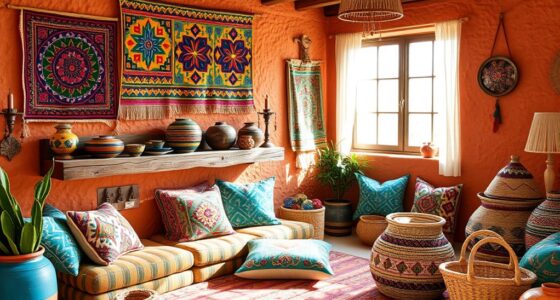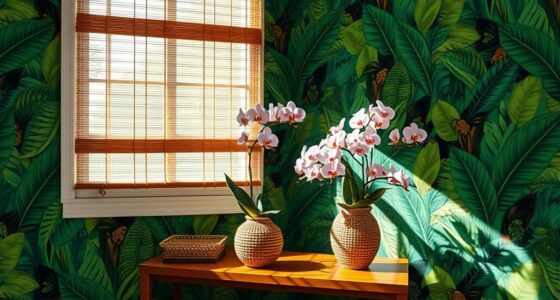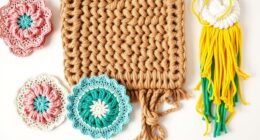The hippie movement greatly shaped boho aesthetics by emphasizing free-spirited fashion, individuality, and eco-conscious choices. You’ll notice relaxed, unconventional styles like flowy skirts, embroidered fabrics, and layered accessories that reflect a desire for authenticity and harmony with nature. This movement also promoted sustainability through reuse and natural materials, encouraging self-expression and a carefree attitude. If you keep exploring, you’ll discover how these principles continue to influence modern style and lifestyle choices today.
Key Takeaways
- Introduced relaxed, free-spirited styles emphasizing individuality and peace, foundational to boho aesthetics.
- Promoted sustainable fashion through reuse, natural fabrics, and eco-conscious practices, shaping eco-friendly boho trends.
- Emphasized authentic self-expression with vibrant colors, layered accessories, and mixed textiles, core elements of boho style.
- Challenged traditional fashion norms, inspiring a bohemian look rooted in freedom, creativity, and imperfection.
- Legacy of promoting authenticity, sustainability, and peace, which continue to influence modern boho aesthetics.

The hippie movement of the 1960s revolutionized fashion and culture by embracing free-spirited, unconventional styles that emphasized individuality and peace. You might notice how this era championed a relaxed, effortless look that broke away from traditional fashion rules. The movement’s influence extends beyond clothing, shaping a broader ethos rooted in sustainable fashion and a free-spirited lifestyle. You see it in the flowy skirts, embroidered garments, and layered accessories that became symbols of rejecting mainstream consumerism and embracing more meaningful choices. These styles weren’t just about aesthetics—they reflected a desire to live authentically, in harmony with nature and with oneself. Additionally, the movement’s emphasis on clothing sustainability encouraged the reuse and repurposing of garments, laying the groundwork for today’s eco-conscious fashion practices. Your appreciation for boho aesthetics today can be traced directly to this era’s attitude. The hippies prioritized sustainability long before it became a widespread concern. They often repurposed clothing, used natural fabrics, and avoided fast fashion, emphasizing eco-conscious practices. This approach aligns perfectly with the modern idea of sustainable fashion—making mindful choices that lessen environmental impact while expressing your unique style. When you wear a vintage dress or craft your accessories from recycled materials, you’re continuing the movement’s legacy of valuing quality, longevity, and environmental responsibility. The hippie’s rejection of mass-produced, disposable fashion encourages you to contemplate the origins of your wardrobe and to choose pieces that tell a story, rather than just fleeting trends. Living a free-spirited lifestyle was central to the hippie ethos, and it’s something you can embrace too. It’s about more than just clothes; it’s an attitude that celebrates freedom, creativity, and connection. You’re encouraged to mix and match textiles, experiment with vibrant colors, and wear your personality on your sleeve. This approach to fashion invites self-expression and confidence, breaking free from rigid norms. By adopting boho aesthetics inspired by the hippies, you’re also adopting a mindset that values peace, love, and harmony—both with others and with the environment. This lifestyle promotes authenticity and mindfulness, urging you to seek beauty in imperfection and to cherish experiences over material possessions. In essence, the hippie movement’s contribution to boho aesthetics is profound. It’s not just about a style but a way of living that champions sustainability and freedom. When you choose clothing and accessories rooted in this philosophy, you participate in a cultural shift that values individuality, ecological responsibility, and a peaceful, free-spirited way of life. This legacy invites you to express yourself authentically, respecting the planet and embracing your unique journey.
Frequently Asked Questions
How Did Hippie Music Influence Boho Fashion?
Hippie music influences boho fashion through its vibrant, free-spirited vibe inspired by hippie festivals and psychedelic visuals. You’ll notice flowing fabrics, tie-dye patterns, and layered accessories reflecting the colorful, eclectic style of the era. The music’s emphasis on peace, love, and self-expression encourages you to embrace relaxed, bohemian clothing. This connection creates a look that’s both artistic and rebellious, capturing the essence of hippie culture.
Did Specific Hippie Events Shape Boho Aesthetic Trends?
Yes, specific hippie events like the Summer of Love and Woodstock shaped boho aesthetic trends. These gatherings emphasized flower power, with vibrant floral patterns and accessories, and promoted communal living, inspiring relaxed, free-spirited styles. You can see these influences today in flowing fabrics, earthy tones, and eclectic accessories, reflecting the movement’s emphasis on peace, love, and unity. These events truly laid the foundation for boho fashion’s carefree, artistic vibe.
Are There Notable Designers Inspired by Hippie Culture?
Yes, you’ll find notable designers inspired by hippie culture, especially in hippie-inspired accessories that evoke that free-spirited vibe. Many incorporate boho elements into their collections, often showcasing boho runway collaborations that highlight flowing fabrics, earthy tones, and eclectic details. These designers blend vintage hippie influences with modern fashion, creating unique pieces that resonate with boho aesthetics and appeal to those seeking a relaxed, bohemian style.
How Has Boho Fashion Evolved Since the Hippie Era?
They say fashion is ever-changing, but boho style has evolved beautifully since the hippie era. You now see a richer boho color palette, blending earthy tones with vibrant hues, and hippie accessories like layered jewelry and fringe bags remain popular. Today’s boho fashion is more polished yet retains that free-spirited essence, allowing you to express individuality while embracing timeless elements from the past.
What Role Did Hippie Philosophy Play in Boho Style?
Hippie philosophy deeply influences boho style by embodying free-spirited values and anti-establishment attitudes. You embrace relaxed, unconventional fashion that celebrates individuality and peace. This mindset encourages you to mix patterns, layers, and natural fabrics, reflecting a rejection of mainstream norms. By channeling these ideals, you create a boho look that’s authentic, carefree, and rooted in a desire for personal freedom and harmony with nature.
Conclusion
You see how the hippie movement shaped boho aesthetics through its embrace of freedom, individuality, and self-expression. It’s about more than just fashion—it’s about a way of life that celebrates authenticity, creativity, and connection. By adopting these principles, you participate in a timeless movement that values peace over profit, nature over nurture, and originality over conformity. Embrace the spirit of the hippies, and let your style reflect your soul’s true freedom and your heart’s deepest desires.










